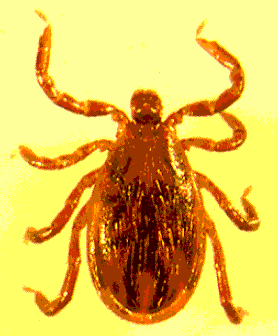Acari
Mites and Ticks


The Acari include ticks, mites, and their kin. The black-legged tick, or deer tick, Ixodes scapularis, shown here is a relatively large member of the Acari, about 5 mm long. Many other members of the Acari are microscopic, like this unidentified mite photographed with UCMP's Environmental Scanning Electron Microscope.

With small size has come morphological change: the segmentation of the opisthosoma and the distinction between prosoma and opisthosoma has been almost completely lost, as have the heart and eyes in many species. The chelicerae (first appendages) may be clawed mouthparts or may be modified for piercing, as in ticks. Some mites have even reduced or lost one, two, or three pairs of legs.
Mites and ticks which feed on vertebrate hair or blood often carry disease organisms, such as spirochete bacteria, responsible for relapsing fever and Lyme disease. Others are rather unpleasant parasites themselves, such as ticks, chiggers, and the skin mites that cause mange and scabies. Yet most mites are free-living, found in great abundance in soils, plant litter, and even in water. Those that parasitize agricultural insect pests may be beneficial. In all there are about 30,000 species of Acari known, and that is probably only a fraction of the actual number of species.
Mites were among the first land arthropods; the oldest known so far are Late Devonian. However, because of their small size, the Acari are uncommon in the fossil record. A few are known from the Carboniferous, and more from Tertiary amber.
The image of Ixodes is taken from the Entomology Image Gallery at Iowa State University. Their pictures and movies of live ticks are a must-see; the mosquitos and lice are also well worth a visit.

Petrunkevitch, A. 1960. Arachnida. P42-P162 in Moore, R.C. (ed.) Treatise on Invertebrate Paleontology. Part P: Arthropoda 2: Chelicerata. Geological Society of America and University of Kansas Press, Lawrence, Kansas.

